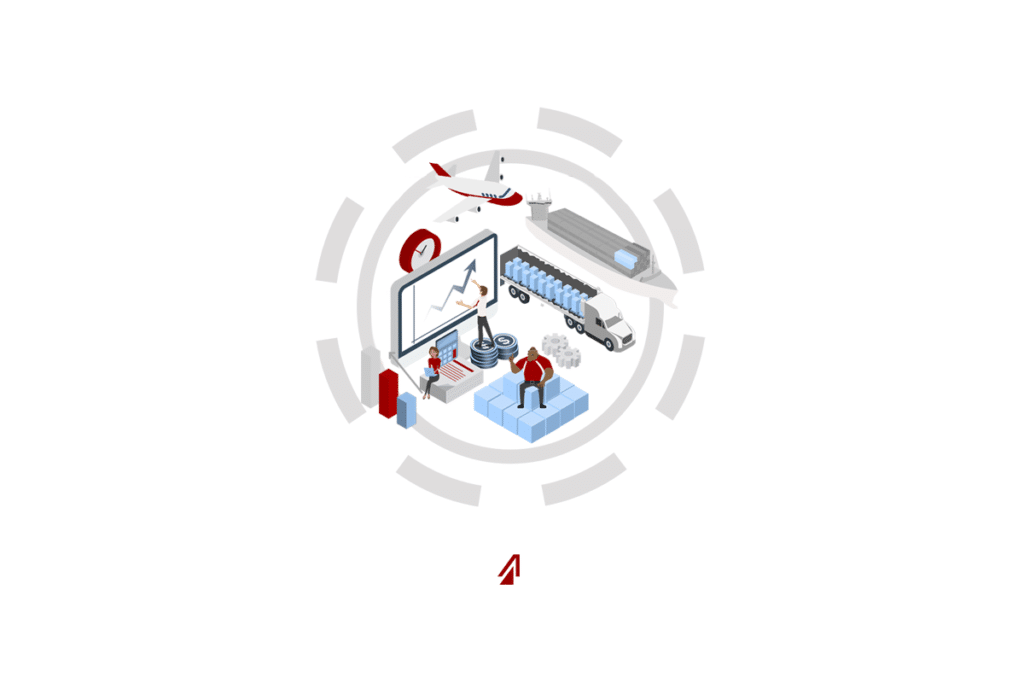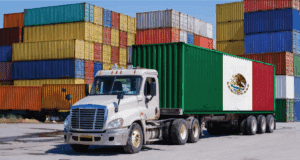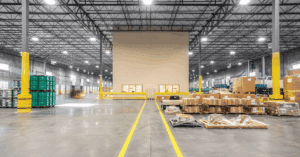This state of the Logistics Industry report will address the effects of the Coronavirus on the logistics industry, the current environment of the TL and LTL segment, and the outlook of the logistics industry in general.
Overall, this report will show both opportunities and challenges brought on by the coronavirus, and what to expect in the coming years.
Coronavirus and Logistics
The COVID-19 virus has taken a large toll on the US and global economies, with state restrictions causing the loss of an estimated 22 million jobs throughout 2020. Logistics jobs made up about 3% of the total job losses and has proven to be one of the most vital sectors in the US employment sphere. How the US economy will proceed is yet to be determined.
On one hand, there is the possibility of a second wave of COVID-19 infections and deaths. States will follow with cautious restrictions and will implement safeguards to slow the spread. This will significantly inhibit economic growth.
On the other hand, despite contractions in the GDP and in employment numbers, there is significant reason for optimism for logistics and the US economy as a whole. Americans have proved to be innovative and are finding ways to thrive in spite of growing mandates. As a result, job numbers are climbing. Nearly half of the lost jobs are returning (approximately 9.3 million at the time of writing) and the second half of 2020 has shown to have a U-Shaped recovery.
For the logistics industry, the mood is mixed. Currently, shipping, transportation, and other supply chain activities are a top priority for both the public and private sector as lawmakers strive to move manufacturing and other logistics operations to the US from China. Demand for logistics and logistics-related activities is as high as ever, but the supply is currently reduced. The industry is facing driver shortages, office and warehouse labor shortages or reductions, and logistics company failures. However, in spite of these challenges, there will be significant opportunities for growth and innovation over the course of 2021.
GDP
U.S. GDP has an estimated contraction of 3.7% in 2020. However, there is hope that a rebound could occur in 2021 with a growth rate of 4.0%. It is estimated that growth will slow in 2022 and 2023 at 3.0% and 2.5% respectively.
Employment
As 2020 closes, we are expected to average a 7.6% unemployment rate. This average is mostly attributed to the rate spike, that peaked at 14.7%, in April as many companies responded to the Coronavirus outbreak with layoffs. In 2021, it is predicted that we will see a reduction to 5.5% and then to 4.6% and 4.0% in 2022 and 2023.
Inflation
Currently, Median Core/Median CPI inflation rates (rates without gas and food prices because of their volatility) are below the Fed target rates. The Fed is currently targeting 2.0% inflation, but 2020 rates have held at 1.2%. Forecasting for the next 3 years – Median CPI is estimated to be 1.7% in 2021, 1.8% in 2022, and 2.0% in 2023.
Manufacturing
For the manufacturing industry, trends are showing slower, but sustained, growth. The New York Federal Reserve shows this slow growth in their “Empire State manufacturing survey general business index” by dropping the index score 14 points to a mere 3.7. The most significant issue for many companies at the moment is the lack of cash flow. Despite the speed, many analysts are optimistic about 2021, due to the industries’ performance and recovery during the pandemic.

Interest Rates
The Federal Reserve has announced that it will keep the interest rate benchmark at its present level until inflation reaches 2.0% over a longer time period. Because of COVID, the Fed lowered the Fed Funds rate to between 0.0% and 0.25%. They have stated they desire to keep long-term rates down as a part of their quantitative easing program.
The Fed has also set long-term fixed rate mortgage benchmarks by reducing the supply of treasuries in the market.
TL / LTL Overview
Capacity Crunch
Capacity issues are growing and trucking executives project that it is only going to tighten over the coming months. Customer warehouses and docks are “overflowing with merchandise, indicating a tight capacity with no letup in sight.”
Conditions are strained due to the existing driver shortage (more detail later) as well as COVID concerns, new and existing regulations, and the upcoming holiday season. Combined, the driver market is becoming more limited, and driver demand is exceeding supply.
Regulations
Over the course of 2020, regulations have both changed and increased, compounding trucking companies’ concerns.
First, ELDs are firmly established and are becoming a regular part of drivers’ lives.
Next, hours of service regulations were reformed and implemented in September to change driving schedules. In summary, shorthaul drivers are given additional daily hours of service, driving windows are expanded during adverse weather, 30 minute rest periods are amended to allow breaks during “on-duty, non-driving” times, and sleep schedules can be broken up to better accommodate driver needs.
Lastly, greenhouse gas regulations from 2016 went into effect in 2020. Designated “Phase 2” this operation regulates model 2021 trucks to a more rigorous emissions and fuel efficiency standard. These standards apply directly to class 2b-8 trucks, new engines, and designated “new” trailers. The next phases of these standards are expected to take place in 2024 and 2027.
Rates
Many of the factors discussed in the capacity section reflect significant rate increases in the logistics market. Experts believe that “Spot market premiums are up 60 percent (low point in this past spring), but show signs of a turn” and that the disruption impact may be “nearing its peak.” The contract pricing market is inflated as well, but will have less pressure when spot volumes and spot premiums return to normalcy.
Behaviors
Consumer behavior in both B2B and B2C markets are gravitating towards speed. The name of the game is lean and efficient. B2C is driven by the rising e-commerce market and the ease and convenience of online purchases. B2B is looking for speed to meet their own customers’ demands. Shippers are looking to become “leaner” and are developing a stronger “just-in-time” (JIT) mindset. That means less storage and safety stock as well as building products as needed. Many transportation companies are pivoting to meet this growing demand and are working on developing more efficient operations to meet the challenge.
But, that could be expected. The pandemic implications, however, were not expected. With COVID, many consumers (both B2B and B2C) changed how they interacted with producers/shippers. Brick and mortar shopping was restricted for many states, and that drove a surge in online/e-commerce shopping. Combine that with the fact that many shippers could not create products ahead, many companies in the US learned to be lean out of necessity rather than by choice.
Technology
Logistics technology is one of the fastest growing portions of the logistics market. New devices and systems are developed daily to increase visibility, manageability, data harvesting capabilities, decision making, and security. Some of the most exciting emerging technologies are:
• Blockchain
• IoT and Big Data
• AI and Machine Learning
• 5G
Blockchain was described by Don and Alex Tapscott, authors of Blockchain Revolution as, “an incorruptible digital ledger of economic transactions that can be programmed to record not just financial transactions but virtually everything of value.” Put simply it is a strong digital ledger. Transactions are recorded transparently and are held securely by a network of servers. Recently, more logistics operations are stored in blockchain such as contracts, operations logs, and other documents – resulting in more efficient, accurate, and secure operations.
Internet of things (IoT) refers to the capability of installing the internet, or internet capabilities, on a device. This makes devices like scanners or GPS trackers more accessible and more useful. Combining with IoT with Big Data allows for better decision making. IoT collects the data, and Big Data processes the raw data into a useful collection that stakeholders can use to make decisions.
AI and Machine learning are computer processes that have assisted in many logistics operations from day to day tasks to company management. These are sophisticated computer software systems that analyze data to recognize patterns. Then, the computer will learn from previous computations to make reliable, repeatable decisions and results.
5G is the next big thing logistics technology. It produces incredibly fast internet speeds with limitless applications. Some of the most obvious applications for logistics are in data aggregation and modelling, battery life, artificial intelligence of things, and 5G at the edge.
Fuel Impact
According to the International Energy Agency, oil demand for 2021 will decrease by approximately 8.8 million barrels per day. Pre-COVID/2019 numbers had a demand of nearly 100.1 million barrels daily, but demand has decreased. “It is far too early to know how and when [COVID] vaccines will allow normal life to resume. For now, our forecasts do not anticipate a significant impact in the first half of 2021,” the agency said.
The IEA does predict a recovery in oil demand next year of 5.8 million barrels per day, but this is only 300,000 barrels per day higher than its forecast a month ago. Surges in COVID-19 cases across the United States and Europe will drag on global demand growth, while major consumption hubs such as China and India are seeing an improvement in energy use.
Price decreases are also expected match demand. At the time of this writing, the average price for a gallon of diesel was $2.46 /mile. That is down $.604 from last year.

Driver Concerns
Over the course of 2020, both drivers and the trucking industry have faced a number of concerns.
First, this year, there were 80,000 fewer drivers than in 2019. There are a number of reasons why drivers are leaving the industry including age, pay, and lifestyle. At the same time, the logistics market is not taking advantage of untapped potential such as female drivers or drivers aged 18-20. Job alternatives and regulations have also been a deterrent from hiring new drivers, and is something the logistics industry needs to address.
Next, the coronavirus has also played a part in reducing driver numbers. For instance:
• The federal stimulus package (CARES Act) has increased unemployment benefits and is keeping more drivers from returning to work.
• Drug consumption has increased during the pandemic, and 40,000 drivers failed drug tests between January and September of 2020. They were removed by the CDL (Drug & Alcohol Clearinghouse)
• As many as 20% of trucking schools are closed due to COVID (last update November 11) and the ones that remain open are graduating fewer students due to social distancing requirements.
Finally, another concern for many companies is the desire for more drivers to migrate from fleet payrolls to more lucrative owner-operator roles. Q3 saw as many as 10,000 new motor carrier registrations, but the driver pool is not increasing. Therefore, companies must pivot to be more competitive with their driver base.

Overall, 2021 is favorable for higher freight volumes and higher rates for the next two years – depending on the effect of COVID-19.
The Big Picture
Logistics in 2021 has significant promise but also poses significant potential challenges. The industry can look forward to increasing freight and driver demand, lower fuel costs, and substantial technological innovation. Companies will have more visibility and control than ever before and be able to make decisions with more data available. The challenge is that they will certainly need to make difficult decisions in 2021. The coronavirus has caused significant contractions in the economy and job market, meaning companies will need to cut costs wherever possible. Other challenges include heavier regulations, stronger requirements from customers, and reduced driver supply.
But, there is hope. If 2020 has taught anything, it is how to be agile. Companies are learning to adapt and innovate to meet these new challenges. They are becoming stronger and will perform better as the immediate crisis ends.
Sources:
(https://www.thebalance.com/us-economic-outlook-3305669)
(https://www.joc.com/trucking-logistics/truckload-freight/us-truck-capacity-tightens-%E2%80%98shippers-choice%E2%80%99-first-line_20200924.html)
(https://www.trucker.com/news/article/21140364/what-drivers-need-to-know-about-new-hos-rules)
(https://www.truckinginfo.com/304050/how-ghg-phase-2-changes-the-way-you-spec-trucks)
(https://markets.businessinsider.com/news/stocks/oil-demand-outlook-2021-covid-19-vaccine-iea-forecasts-2020-11-1029795224)



